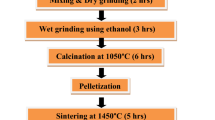Abstract
Ceramics have high hardness and mechanical strength, excellent chemical and thermal stabilities, and particular electromagnetic and optical properties. Based on these unique properties, they have been widely used in our life, industry activities, and various environmental and energy fields. The durability of ceramics is derived from strong chemical bonding, that is, covalent and ionic bonds, and tight atomic packing. The electrical properties are dominated by crystal and electronic band structures and typically classified into insulator, dielectric, semiconductor, and metallic conductor. Typical covalent crystals are diamond, graphite, and hexagonal boron nitride (h-BN). Diamond, having 3D carbon network, is extremely hard, whereas graphite and h-BN are soft due to the hexagonal layer structure. Structural principle in ionic crystal is the alternate arrangement of cation and anion different in charge and size. The coordination configuration consisting of centered cation and surrounding anions is the elemental unit: for example, silica is constructed by SiO4 tetrahedrons and titania by TiO6 octahedrons. Lattice defects, such as vacancy and interstitial atom, provide a large influence on semiconductor and ionic conductor. Glass has a random network structure and has been applied in optical fields. Recent trend is the dimensional control of morphology from zero- to three-order. New functions of ceramics have been created using nanoparticle, nanofiber, nanosheet, hybrid, and nanoporous materials.
Access this chapter
Tax calculation will be finalised at checkout
Purchases are for personal use only
Similar content being viewed by others
Further Readings
W. D. Kingery, H. K. Bowen, D. R. Uhlmann, Introduction to Ceramics, 2nd edn. (Wiley, New York, 1976); W. Komatsu, T. Sata, Y. Moriyoshi, K. Kitazawa, K. Uematsu, Introduction of Materials Science in Ceramics: Basic Edition, Japanese Translation (Uchida Rokakuho Publishing Co., Ltd., Tokyo, 1980)
F. S. Galasso, International Series of Monographs in Solid State Physics, Vol. 7: Structure and Properties of Inorganic Solids (Pergamon Press Ltd., Oxford, 1970); M. Kato, K. Uematsu, Crystal Chemistry of Fine Ceramics: Structure and Property of Inorganic Solid Compounds, 3rd Japanese Translation (AGNE Gijutsu Center Inc., Tokyo, 2002)
Y. Arai, Materials Chemistry of Ceramics (Dainippon Tosho Publishing Co., Ltd., Tokyo, 1980)
H. Yanagida, K. Koumoto, M. Miyayama, Chemistry of Ceramics, 2nd edn. (Maruzen Publishing Co., Ltd., Tokyo, 1993)
Y. Moriyoshi, T. Sasamoto, K. Uematsu, Y. Ikuma, Basic Science of Ceramics, 4th edn. (Uchida Rokakuho Publishing Co., Ltd., Tokyo, 1995)
J. Shiokawa, Introduction to Inorganic Materials (Maruzen Publishing Co., Ltd., Tokyo, 1996)
T. Endo, H. Iwasaki, T. Tsurumi, A. Nakahira, H. Takizawa, Introduction to Crystal Chemistry (Kodansha Scientific Ltd., Tokyo, 2000)
Author information
Authors and Affiliations
Corresponding author
Editor information
Editors and Affiliations
Rights and permissions
Copyright information
© 2019 Springer Nature Singapore Pte Ltd.
About this chapter
Cite this chapter
Hojo, J., Inada, M. (2019). Crystal Structures of Inorganic Materials. In: Hojo, J. (eds) Materials Chemistry of Ceramics. Springer, Singapore. https://doi.org/10.1007/978-981-13-9935-0_1
Download citation
DOI: https://doi.org/10.1007/978-981-13-9935-0_1
Published:
Publisher Name: Springer, Singapore
Print ISBN: 978-981-13-9934-3
Online ISBN: 978-981-13-9935-0
eBook Packages: Chemistry and Materials ScienceChemistry and Material Science (R0)




